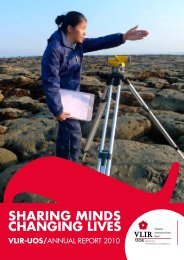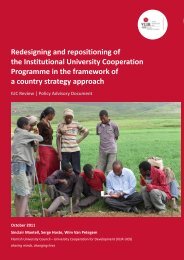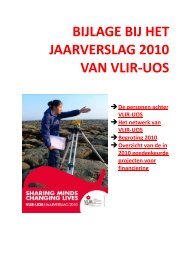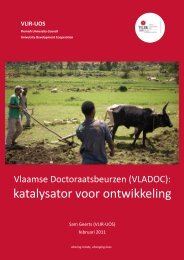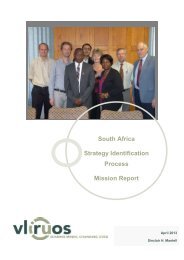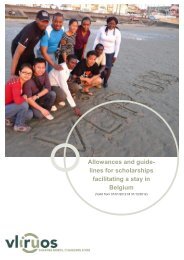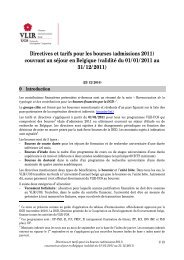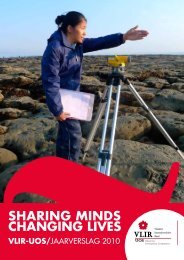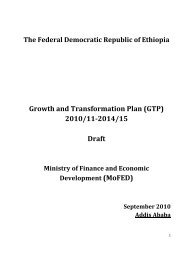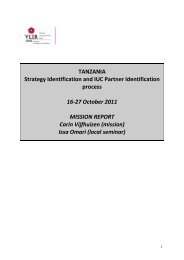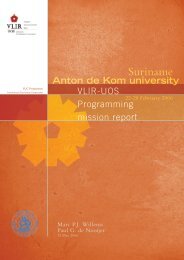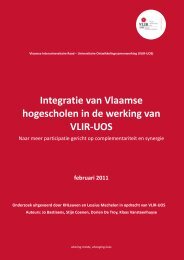Education Sector Development Program - VLIR-UOS
Education Sector Development Program - VLIR-UOS
Education Sector Development Program - VLIR-UOS
You also want an ePaper? Increase the reach of your titles
YUMPU automatically turns print PDFs into web optimized ePapers that Google loves.
<strong>Education</strong> <strong>Sector</strong> <strong>Development</strong> <strong>Program</strong> IV<br />
A sense of ownership by<br />
the community will be<br />
essential to achieve the<br />
ESDP IV goals.<br />
community participation is likely to be higher<br />
where demand for education exists and in<br />
turn when actively supported by government.<br />
However, the adequate technical and<br />
financial support to maximize the benefits<br />
of community participation has not been<br />
present everywhere. The government has<br />
reviewed and improved the guidelines for<br />
Community Participation, School Management<br />
and Financing, which await official endorsement.<br />
Main challenges<br />
• Policies about community<br />
contributions are not clearly<br />
articulated and communities are<br />
not well informed about them<br />
• Data on community participation<br />
are not properly reported<br />
• Some communities are<br />
overburdened and/or stressed<br />
by contributions; the risk of<br />
“community fatigue” and a<br />
decrease in their participation<br />
may occur.<br />
2. Expected program outcomes<br />
3. Policy and strategies<br />
During the implementation of ESDP IV,<br />
communities will continue to be strongly involved<br />
in education especially at primary level. However,<br />
in comparison to ESDP III, some changes are<br />
introduced.<br />
Community involvement will focus on areas which<br />
have less financial implications. This relates in<br />
particular to activities to increase enrolment and<br />
to decrease early drop-out. Several strategies will<br />
aim at ensuring that community organizations<br />
and PSTAs monitor absenteeism of children and<br />
intervene quickly to convince parents to continue<br />
sending their children to school. The preparation<br />
of school improvement programs will involve<br />
communities and their representatives and will<br />
be guided by supervisors so that they include<br />
activities aimed at improving school management<br />
and student retention.<br />
While communities will be required to continue<br />
contributing labor and some finances to school<br />
construction, their expected involvement will<br />
take more into account the level of economic<br />
development of each community so as to keep<br />
a balance between requested contributions and<br />
the potential of the community.<br />
A sense of ownership by the community will be<br />
essential to achieve the ESDP IV goals.<br />
❚<br />
❚<br />
❚<br />
Enrolment increased and dropout<br />
reduced through strengthened<br />
community awareness<br />
Quality of school infrastructure and<br />
facilities improved through financial,<br />
material and labor contribution by the<br />
community according to the level of its<br />
resources and abilities<br />
Community participation strengthened<br />
in the management of schools<br />
Key outcome targets<br />
The NER and GER, especially of girls, and the<br />
drop-out rates in early grades will improve in<br />
previously underserved areas<br />
The contributions in financial and labor terms<br />
by communities in renovating/constructing and<br />
or replenishing school facilities will increase, as<br />
their resources permit<br />
In all primary schools, the school improvement<br />
plan will be prepared with support by the<br />
community<br />
52



